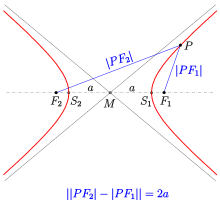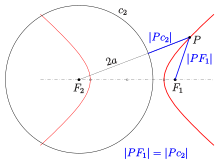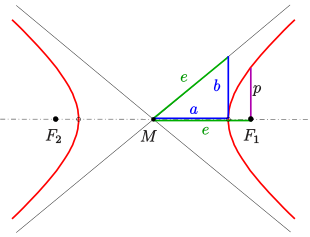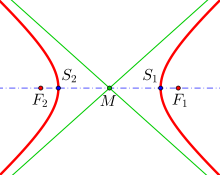Hyperbola
In plane geometry, a hyperbola is a special curve consisting of two symmetrical branches extending to infinity. Along with the circle, the parabola and the ellipse, it is one of the conic sections that result from the intersection of a plane with a straight circular cone.
Like ellipse and parabola, hyperbolas can be defined as locus curves in the plane (see section Definition of a hyperbola as locus curve).
Any hyperbola can be 
The hyperbola was discovered by Menaichmos. The name, introduced by Apollonios of Perge, comes from Greek and refers to hyperbole (ὑπερβολή hyperbolé, from ancient Greek βάλλειν bállein, German 'werfen', ὑπερβάλλειν hyperballein, German 'to throw beyond the target') of the intersection angle (or numerical eccentricity ε 


Definition of a hyperbola as a locus
A hyperbola is defined as the set of all points 



The center 





That the intersection of a straight circular cone with a plane steeper than the cone's generatrices and not containing the cone's apex is a hyperbola is shown by proving the above defining property using Dandelin's spheres (see section Hyperbola as a conic section).
Remark:
The equation 









of the hyperbola. The left branch 


The generation of a hyperbola with guide circles should not be confused with the generation of a hyperbola with guide lines (see below).
Due to the guiding circle property, a branch of a hyperbola is the equidistance curve to one of its foci and the guiding circle with the other focus as center.

Hyperbola: definition and asymptotes

Hyperbola: definition with guide circle
Hyperbola in 1st main layer
Equation
The equation of the hyperbola obtains a particularly simple form if it is in 1st principal position, that is, if the two foci lie on the 




For any point 





By algebraic transformations and using the abbreviation 
to the equation
is equivalent. The latter equation is called the equation of the hyperbola in 1st principal position.
Vertex
A hyperbola has only two vertices: 



Asymptotes
If we solve the hyperbolic equation for 
Here you can see that the hyperbola for magnitude large 
arbitrarily close. These straight lines pass through the center and are called the asymptotes of the hyperbola
Half parameter p
The half length of a hyperbolic chord passing through a focal point and perpendicular to the principal axis is called the half parameter (sometimes also transverse dimension or just parameter) 
Other meaning of 

i.e., 
Tangent
The equation of the tangent line at a hyperbolic point most easily found by

Considering 
Equilateral hyperbola
A hyperbola for which 



Parameter representation with hyperbolic functions
With the hyperbolic functions 

Hyperbola in 2nd main layer
If we swap 


Hyperbola: semiaxes a,b, lin. eccentricity e, half parameter p
Questions and Answers
Q: What is a hyperbola?
A: A hyperbola is a type of conic section, which is a curve formed by the intersection of a cone and a plane. It is created when the plane intersects both halves of a double cone, creating two curves that look exactly like each other but open in opposite directions.
Q: How does one create a hyperbola?
A: A hyperbola is created when the plane intersects both halves of a double cone, creating two curves that look exactly like each other but open in opposite directions. This occurs when the angle between the axis of the cone and the plane is less than the angle between a line on the side of the cone and the plane.
Q: Where can we find examples of hyperbolas in nature?
A: Hyperbolas can be found in many places in nature. For example, an object in open orbit around another object - where it never returns - can move in the shape of a hyperbola. On a sundial, the path followed by the tip of the shadow over time is also shaped as a hyperbola.
Q: What equation describes one well-known example of a hyperbola?
A: One well-known example of an equation describing anhyperbola is f(x)=1/x .
Q: What are some other types of conic sections besides hyperbolae?
A: Other types of conic sections include parabolas, ellipses, and circles.
Q: How do these different types differ from each other?
A: Parabolas are U-shaped curves with one vertex point; ellipses are oval shapes with two focal points; circles have no vertex points or focal points; and finally,hyperbolae have two separate curved lines opening outwards from their center point at different angles.
Search within the encyclopedia















